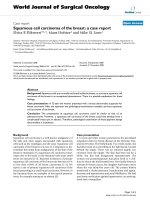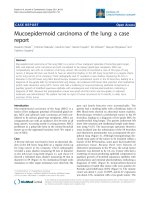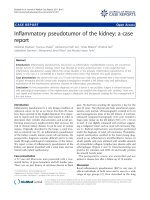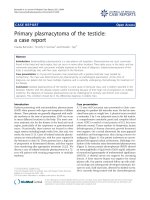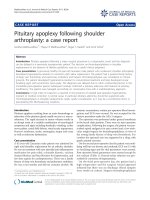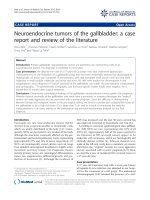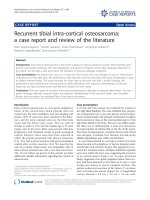Báo cáo y học: "Mucoepidermoid carcinoma of the lung: a case report" docx
Bạn đang xem bản rút gọn của tài liệu. Xem và tải ngay bản đầy đủ của tài liệu tại đây (1.39 MB, 3 trang )
CAS E REP O R T Open Access
Mucoepidermoid carcinoma of the lung: a case
report
Masahiro Kitada
1*
, Yoshinari Matsuda
1
, Kazuhiro Sato
1
, Satoshi Hayashi
1
, Kei Ishibashi
1
, Naoyuki Miyokawa
2
and
Tadahiro Sasajima
1
Abstract
Mucoepidermoid carcinoma of the lung (MEC) is a tumor of low malignant potential of bronchial gland origin.
MEC and adenoid cystic carcinoma are both considered to be salivary gland-type neoplasms. MECs are
comparatively rare with an incidence of all lung cancers. We recently encountered a case of this type of lung
cancer. A 60-year-old man was found to have an abnormal shadow in the left lower lung field on a regular check-
up for lung cancer at his company. Chest radiography and CT revealed a mas s shadow measuring 30 mm in
diameter in the left lower lung field. Bronchoscopy revealed a protuberant tumor in the S9 bronchus, leading to a
diagnosis of low-grade MEC by transbronchial lung biopsy. He underwent left lower lobe resection and mediastinal
lymph node dissection using VATS. Tumor cells had a scattering of mucus-producing epithelial components in
papillary growth of stratified squamous epithelia with anisokaryosis and minimal pleomorphism, indicating a
diagnosis of MEC. Because the postoperative course was good and the tumor was low-grade, no adjuvant
treatment was administered. The patient has had no signs of tumor recurrence for 9 months, to date, since
resection of the tumor
Introduction
Mucoepidermoid carcinoma of the lung (MEC) is a
tumor of low malignant potential of bronchial gland ori-
gin. MEC and adenoid cystic carcinoma are both con-
sidered to be salivary gland-type neoplasms. MECs are
compa ratively rare with an incidence of 0.1%-0.2% of all
lung cancers, occurring mostly in yo ung persons. MECs
proliferate in a polyp-like form in the central bronchial
lumen up to the segmental bronchus level. We report a
case of MEC.
Case
A 60 -year-old man was found to have an abnormal sha-
dow in the left lower lung f ield on a regular check-up
for lung cancer at his company. Chest radiography
revealed a mass shadow m easuring 30 mm in diameter
in the left lower lung field (Figure 1), a nd chest CT
showed a lobulated mass shadow measuring 30 mm in
diameter in S9 (Figure 2). No mediastinal lymph node
metastasis or other organ metastases were observed. His
past and family histories were unremarkable. The
patient had a smoking habit with a Brinkman index of
800. Blood tests showed no abnormal tumor markers.
Bronchoscopy revealed a protuberant tumor in the S9
bronchus, leading to a diagnosis of low-grade MEC by
transbronchial lung biopsy. The patient underwent left
lower lobe resection and mediastinal lymph node dissec-
tion using VATS. The macroscopic specimen showed a
mass localized into the arborization of the S9 bronchus
and obstructive pneumonitis was accompanied the per-
ipheral lung ( Figure 3). Although histopathology dis-
closed most parts of the tumor to be localized within a
branch of th e B9 bronchus, some parts had invaded the
pulmonary tissue. Because there were features of
obstructive pneumonia in the S9 area, the actual tumor
diameter was deemed to be 2.4 cm. Tumor cells had a
scattering of mucus-producing epithelial components in
papillary growth of stratifi ed squamous epithelia with
anisokaryosis and minimal pleomorphism, indicating a
diagnosis of MEC (Figure 4). Immunohistochemical
examination revea led that tumor cells were positive for
Periodic acid-Schiff stain (P AS) (Figure 5). The mitotic
count was about 1-2 per 10 HPP, and ki-67 expression
was about 15%, consistent with a low-grade tumor. The
* Correspondence:
1
Department of Surgery, Asahikawa Medical University, Asahikawa, Japan
Full list of author information is available at the end of the article
Kitada et al. Journal of Cardiothoracic Surgery 2011, 6:132
/>© 2011 Kitada et al; licensee BioMed Central Ltd. This is an Open Access article distributed under the terms of the Creative Commons
Attribution License (htt p://creativecommons.org/licenses/by/2.0), which permits unrestricted use, dis tribution, and reproduction in
any medium, provided the original work is properly cited.
tumor had a keratin profile of CK7 (+), CK20 (-), and
CK5/6 (+), and was determined to be a primary lung
cancer (Figure 5). Lymph-vascular invasion, vascular
invasion, and lymph node metastasis were negative.
Because the postoperative course was good and the
tumor was low-grade, no adjuvant treatment was admi-
nistered. The patient has had no signs of tumor recur-
rence for 9 months, to date, since resection of the
tumor.
Discussion
MEC is a malignant tumor of bronchial gland origin
first described by Smetana in 1952 [1], with a presumed
incidence of 0.1%-0.2% of all lung cancers [2]. This
tumor has been reported to occur in relatively young
personsascomparedwithmostotherlungcancers[3].
MEC generally occurs in the central bronchial region,
and many of these tumo rs are detected based on symp-
toms such as coughing, sputum, bloody sputum and
wheezing, and chest pain, chest oppression and fever
associated with obstructive pneumonia. Because this
Figure 1 Chest radiography revealed a mass shadow in the left
lower lung field.
Figure 2 CT showed a mass shadow measuring 30 mm in
diameter in S9.
Figure 3 The macroscopic specimen showed a mass localized
into the arborization of the S9 bronchus and obstructive
pneumonitis was accompanied at the peripheral lung.
Figure 4 Histological findings showing a mass diagnosed MEC.
(HE × 200).
Kitada et al. Journal of Cardiothoracic Surgery 2011, 6:132
/>Page 2 of 3
disease originates from glandular tissue identical with
salivary glands located in the submucosa of the trachea
and bronchus, it is included among carcinomas of sali-
vary-gland types along with adenoid cystic carcinoma
according to the WHO histological classification of lung
cancer. MEC is characterized by a mixture of mucus-
producing, glandular and squamous epithelial cells, as
well as intermediate cells with both properties at various
percentages, and by various growth patterns such as cys-
tic, papillary, and solid structures [4]. Mucus-producing
cells form lumens in some cases. Most MEC cases show
low-grade 1-2 nuclear atypia with many squamous
epithelial components, while high- grade cases have pre-
dominantly mucus-produc ing cells. Therefore, MEC has
been considered difficult to differentiate from adenos-
quamous cancer [5].
Radical surgery based on lung cancer treatment is per-
formed for MEC, and in recent years this operation has
frequently been performed u sing VATS [6]. In addition,
if this tumor arises in the central bronchus, resection
based on bronch oplasty considering preservation of pul-
monary function is also conducted . Patients with low-
gradeMECgenerallyhaveagoodprognosis,witha5-
year survival rate of 95%, and adjuvant treatment is con-
sidered unnecessary. However, effective treatment mea-
sures for high-grade tumors have not been established,
and these cases reportedly have a poor prognosis [3,7,8].
Under such circumstances, there are several reports on
the efficacy of the tyrosine-kinase inhibitor Gefitinib in
patients with EGFR gene mutations [9,10], and this
molecularly-targeted therapyislikelytoimproveprog-
noses of cases with progressive high-grade and recurrent
MEC. Therefore, EGFR gene muta tions appear to be
important.
Conclusion
MEC is a comparatively rare low-grade tumor, which
reportedly carries a good prognosis. However, the possi-
bility of high-grade MEC should be kept in mind.
Consent statement
Informed consent was obtained from the patient for
publication of this case report and accompanying
images. A copy of the written consent is available for
review by the Editor-in-Chief of this journal.
Author details
1
Department of Surgery, Asahikawa Medical University, Asahikawa, Japan.
2
Department of Clinical Pathology, Asahikawa Medical University, Asahikawa,
Japan.
Authors’ contributions
MK have operated this case and analyzed all data. YM, KS, SH, KI did the
assistant of the operation. NM diagnosed h the pathology of this case.
TS was the professor of the surgical science and had a guide.
All authors read and approved the final manuscript.
Competing interests
The authors declare that they have no competing interests.
Received: 16 June 2011 Accepted: 11 October 2011
Published: 11 October 2011
References
1. Smetana HF, Iverson L, Swan LL: Bronchogenic carcinoma; an analysis of
100 autopsy cases. Mil Surg 1952, 111(5):335-351.
2. Leonardi HK, Jung-Legg Y, Legg MA, Neptune WB: Tracheobronchial
mucoepidermoid carcinoma. J Thoracic CardioVascular Surg 1978,
76:431-438.
3. Yousem SA, Hochholzer L: Mucoepidermoid tumors of the lung. Cancer
1987, 60:1346-1352.
4. Brambilla E, Travis WD, Colby TV, Corrin B, Shimosato Y: The new World
Health Prganization classification of lung tumors. Eur Respir J 2001,
18:1059-1068.
5. Ozlu C, Chirstopherson WM, Allen JD: Mucoepidermoid tumors of the
bronchous. J Thorac Cardiovasc Surg 1961, 42:24-31.
6. Santambrogio L, Cioffi U, De Simone M, Rosso L, Ferrero S, Giunta A: Video-
Assosiated sleeve lobectomy for mucoepidermoid carcinoma of the left
lower lobar brochous: a case report. Chest 2002, 121:635-636.
7. Heitmiller RF, Mathisen DJ, Ferry JA, Mark EJ, Grillo HC: Mucoepidermoid
lung tumors. Ann Thorac Surg 1987, 29:197-204.
8. Julian RM, Marie CA, Jean EL, Jason AW, Brent AW, David EM, Ping Y,
Stephen DC: Primary Salivary Gland-type lung cancer. American Cancer
Society 2007, 15:2253-2259.
9. Han SW, Kim AP, Jeon YK, Oh DY, Lee SH, Kim DW: Mucoepidermoid
carcinoma of lung: potential target of EGFR-directed treatment. Lung
Cancer 2008, 61:30-34.
10. Shilo K, Foss RD, Franks TJ, DePeralta-Venturina M, Travis WD: Pulmonary
mucoepidermoid carcinoma with prominent tumor-assosiated lymphoid
proliferation. Am J Surg Pathol 2005, 29:407-411.
doi:10.1186/1749-8090-6-132
Cite this article as: Kitada et al.: Mucoepidermoid carcinoma of the lung:
a case report. Journal of Cardiothoracic Surgery 2011 6:132.
Figure 5 Immunohistochemical examination revealed that
tumor cells were positive for Periodic acid-Schiff stain (PAS)
(×100).
Kitada et al. Journal of Cardiothoracic Surgery 2011, 6:132
/>Page 3 of 3


